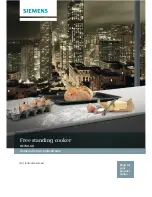
9
Vacuum packing using containers
(Not included into the product)
Vacuum containers are useful for storing delicate foods which easily crushes, and for storing
liquid foodstuffs.
Vacuum containers are neither suitable for cooking nor to be stored in the freezer. For better
performances it’s mandatory to use the specific cycle for containers only. Choose a container
suitable to the vacuum, that can enter the vacuum chamber and that, once inserted, remains
at approximately 1 cm from the closed lid of the packaging machine. Insert the product into
the container and close it.
Filling limits:
SOLID PRODUCTS
100%
BROTHS - INFUSIONS
1/2
VEGETARIAN AND MEAT SAUCES
1/3
CREAMS, CREAM-BASED SAUCES
1/4
PRODUCTS BASED ON EGGS OR EGG WHITE
1/6
Note: introduce sufficiently cold foods; products cooled to 3°C (refrigerator temperature) provide the best
preservation results.
Storage of vacuum packed foods
Here are some important rules to follow for perfect results in the kitchen. Do not try to
vacuum pack foods which are already old or nutritionally lacking: you cannot recover quality
which has already been lost. Only vacuum pack fresh, quality produce.
• Food which has been kept at ambient temperature for an excessive period of time or
which has only just been cooked or prepared, loses its initial moisture and properties
(colour, aroma, flavour, etc.). Consequently, it is best to vacuum pack food which
has been chilled at lenght in the refrigerator until its temperature r3/+6 °C
(standard refrigerator temperature). Packing the products at 3/6°C also avoids serious
damage to the appliance caused by the suction of vapors, which are easily generated at
temperatures above 6°C.
• When using vacuum bags for raw and cooked foods, remember to distribute food evenly
inside the bags to facilitate removal of air. In addition, do not overfill the bags since
this can interfere with sealing, resulting in bags which are not airtight. In this case the
vacuum would not last: repeat the procedure with a new bag and check the seal has no
openings or damage.
• Fill the bags 2/3 full at most for solid food or 1/3 full in case of liquid food or food rich in
humidity.
• It’s important to dry fruit and vegetables after washing, in order to prevent stagnation of
liquid inside bags or containers. Condensation could decrease the vacuum level once the
bag has been sealed.
• To preserve fresh meat for a prolonged period of time, chill it in the refrigerator for at
least 2 hours.
• As regards fish, first of all wash it thoroughly, scale it and remove the fins, dry it and then,
as with meat, chill it properly before vacuum packing it.
• For mature cheeses, like parmigiano reggiano, pecorino, etc. no preparation is necessary,
while for fresh cheeses, wrap them in cling film or use a vacuum container to prevent
them being squashed.
• For cold cuts in containers and in vacuum packed bags, no particular preparation is necessary.
• Storage time depends on a number of factors, including the original quality of the food
stored, the storage temperature, the refrigeration time in the case of cooked foods, the
vacuum level achieved and the quality of the vacuum bag used.






































